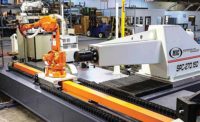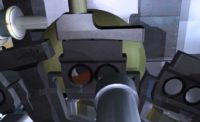If the cartographers at Rand McNally think they have a tough job keeping maps of states and countries up to date, they won’t get any sympathy from the scientists of the Sloan Digital Sky Survey (SDSS). Their job? Map the entire universe.
Formed in 2000, SDSS is a cooperative alliance of astrophysicists from around the world. It has already created the largest 3D map of the universe to date, marking a milestone in astronomical research. Equipped with numerous telescopes and other scientific instruments, the researchers are working on a wide range of projects.
The latest project, SSDS V, aims to enable another qualitative leap in understanding of the physical processes in outer space. It will make possible the first spectroscopic observation of the entire sky in various astronomical dimensions of time in the optical and infrared light spectra. In total, more than 6 million objects will be targeted, including 4 million stars and 300,000 black holes.
Among the objectives of this endeavor is the reconstruction of the history of our home galaxy, the Milky Way. Moreover, researchers plan to retrace the formation of the chemical elements, decrypt the inner workings of stars, examine the formation of planets, and answer many of the open questions that remain with regard to black holes.
Another aspect is the mapping of the interstellar gas masses of the Milky Way—a thousand times more precisely than previously—to describe the “self-regulating mechanisms of galactic ecosystems.” The data related to black holes and the Milky Way are to be collected by two large-scale telescopes: Apache Point in New Mexico and Las Campanas in Chile.
“With the dual perspective from the northern and southern hemisphere, we can view the sky in all directions,” explains Jean-Paul Kneib, Ph.D., professor of astrophysics at Ecole Polytechnique Fédérale de Lausanne in Switzerland.
Inside the telescopes are optical fibers that can be targeted at specific objects in the universe. Individual stars or the luminous accretion discs of black holes can be precisely observed and analyzed.
“Previously, we had to have special plates fabricated for each of the different observation tasks. It took several weeks for each plate to be prepared. The mounting of the fibers was then secured in the plate by hand—a very complex and time-consuming process,” recalls Kneib.
With new technology developed specifically for SDSS V, the rearrangement of the fibers will take no more than a minute instead of weeks. That’s because the fibers in each telescope are now adjusted by means of 500 small machines—referred to by the astronomers as “robots.”
This also allows the researchers to respond immediately to unpredicted cosmic events. If, for example, other telescopes discover a current event such as a supernova, one of the optical elements can be aligned with it with practically no time delay. This enables a detailed analysis of the physical-chemical processes within a time span of supernova development that was not previously possible with this type of instrumentation.
Micron Precision
Each robot consists of two slim cylinders arranged lengthwise with a curved extension at the front end. The rear, thicker cylinder is secured in the plate of the telescope. It forms the alpha unit and turns the central axis of the robot. Mounted eccentrically to the front of this is the beta unit. It likewise moves the fiber tips in the curved end in a circular path.
Through the combination of the two axial movements, the fiber tips can be freely positioned within a circular area. Each circle covered by a robot partially overlaps the circles of adjacent units. In the detection range of the telescope, each point of the sky can thereby be automatically targeted.
Three optical fibers are arranged in the robot. One is designed for light in the visible spectrum and one for the infrared spectrum. The third is used for calibration. With its help, the fiber tips are moved into position in three steps with an accuracy of just a few microns: In a first rough alignment, the two motors turn until the fiber intended for the observation is directed at the target object with a deviation of, on average, 50 microns. A camera in the telescope that is directed at the front ends of the robots now detects the tip of the calibration fiber and measures its position. In two further positioning steps, the robot head is then moved into position with a precision of better than 5 microns.
“Because we save an enormous amount of time with the automatic alignment, we can observe many more objects and perform a corresponding larger number of individual measurements,” explains Kneib. “This effect is raised to an even higher power through the high precision. The diameter of the optical fibers is 100 microns. The diameter of the light spot from an observed cosmic object that hits the telescope is just as big. The more exact these two small surfaces are aligned with one another the greater the light output we have for our measurements and the faster we obtain valid results.”
The technical prerequisites for this extreme accuracy are provided by motors and gearheads from Faulhaber as well as the mechanics developed specifically for this application by Faulhaber subsidiary Micro Precision Systems (MPS) in Biel, Switzerland. The two robot axes are driven by brushless DC-servomotors of the 1218 B series for the alpha axis and the 0620 B series for the beta axis. The first two digits of the type designation indicate the diameter of the micro drives: 12 and 6 millimeters. Their force is transferred to the robot mechanics by means of planetary gearheads. The robot mechanics used here were developed and constructed by MPS. Integrated encoders report the rotary position of the motors to the controller.
Backlash-Free Precision
“To achieve the required precision, we had to eliminate the backlash in the system,” explains Stefane Caseiro, the project manager responsible for the design of the components at MPS.
The engineers accomplished this by, among other things, replacing the conventional coupling between the gearhead shafts and the mechanical axes of the robot with clamp connections and by installing a compression spring to make the gearhead backlash-free.
“Finding the suitable springs alone took several months,” recalls Caseiro.
The search for the right partner for this technical development took Kneib’s team less time.
“There are not even a handful of manufacturers in the entire world who can produce the micro motors with the required quality and durability,” says Kneib. “Faulhaber was on the short list of companies from whom we requested a quotation. We had already worked together successfully with MPS in a prior project. The physical proximity to these specialists is also an advantage. It’s just a 90-minute drive from the university in Lausanne to MPS in Biel. In addition to the outstanding quality and the good mutual experiences, a very decisive argument was that Faulhaber and MPS can supply everything from a single source.”
For more information on high-precision motion control technology, click www.faulhaber.com.
ASSEMBLY ONLINE
For more information on motion control technology, visit www.assemblymag.com to read these articles:
Remembering the Assembly--and Repair--of the Hubble Space Telescope










